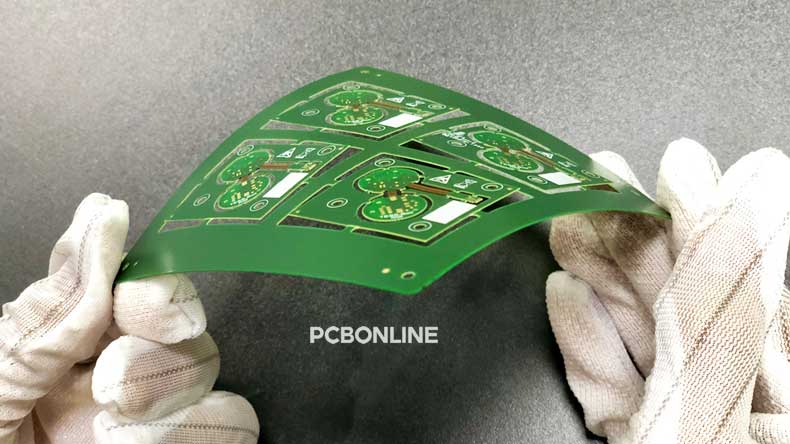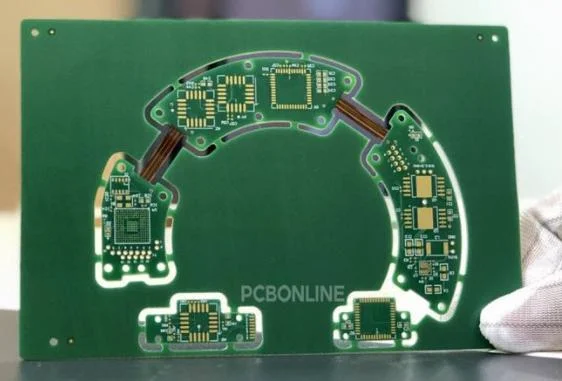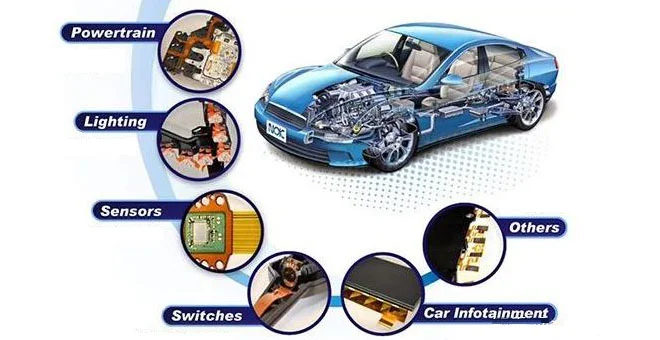
Once, a guy left a comment that said the above rigid-flex circuit boards were merely rigid FR4 PCBs connecting with soft adhesive.
Well, that's wrong. These circuit boards are rigid-flex PCBs, also known as semi-flex PCBs.
On the whole rigid-flex board, you can design any areas to be bendable and any other places to be rigid. Circuits are interconnected in the whole rigid-flex PCB, and you don't need any independent connectors or jacks to take up the compact space anymore!
This article introduces rigid-flex circuit boards, the rigid-flex PCB manufacturer process, rigid-flex PCB manufacturers, and applications of rigid-flex PCBs.
Part 1: What is a Rigid-Flex PCB
A rigid-flex PCB is a flexible PCB that has FR4 PCB layers on the top and bottom. The entire panel of rigid-flex PCBs is polyimide-based and is flexible.

The flexible PCB layers are the core layers of a rigid-flex PCB. Its size is the same as the rigid-flex PCB size.
The rigid PCB layers on the top and bottom are FR4 PCB layers that are laminated to the flex core.
![]()
How did engineers come up with such an ingenious design?
Rigid-flex PCBs were developed from aerospace research for reliable wiring in a compact space. High-density wiring, flexibility, limited space, lightweight, and mechanical strength were all the challenges that were met. Rigid-flex PCBs offer a perfect solution to these challenges.
Now, rigid-flex PCBs are not only used in aerospace, they also find applications in medical, consumer electronics, industrial, communication, automotive, defense, scientific research, etc.
Part 2: Rigid-Flex PCB Manufacturing Process
PCBONLINE is a rigid-flex PCB manufacturer. In rigid-flex PCB fabrication, we first fabricate the flexible PCB layers and then laminate the rigid PCB layers on the flexible core.
According to different designs, rigid-flex PCBs need different fabrication processes.
Here we reveal the normal manufacturing process for rigid-flex PCBs.
Step 1. Prepare the overlay, prepreg, flexible laminates, and rigid PCB laminates
![]()
First, we need to prepare the overlay for the flex section, prepreg (PP), flexible laminates, and rigid PCB laminates and cut them to be in the required size.
Note: For the rigid sections, the areas that will cover the to-be-exposed flex section have only PP. So in these extra rigid areas, we need to remove the copper foil from the laminates.
Step 2. Drill on coverlay, PP, rigid laminates, and flex laminates
![]()
The PCB layers are interconnected by different vias, and we need to drill to make the holes.
On the coverlay, PP, rigid laminates, and flexible laminates, we locate mechanical drill positioning holes.
If the rigid-flex PCB has HDI requirements, we also need to laser drill microvias.
Step 3. Pre-process overlay, PP, and rigid laminates
For the rigid section, the areas that cover the to-be-exposed flex section need to be removed at the end of rigid-flex PCB fabrication.
For this reason, we need to pre-process the overlay, PP, and rigid laminates so that these extra rigid areas can be removed easily later.
Step 4. Circuit generation on the flex PCB
![]()
If the flex core of a rigid-flex PCB has only 1 PCB layer, we transfer the circuit image on the laminate circuit, etch the rolled copper, and keep only the circuit copper traces.
If the flex core has 2, 3, 4, 5, or 6 circuit layers, we need to first generate circuits on the core layers, laminate the alternating layers of PI and rolled annealed copper on the core, and then generate circuits on the rolled annealed copper layers.
Step 5. Laminate coverlay on flex PCB layers
After the circuits are generated in the flex PCB core, we need to implement the automatic optical inspection (AOI). Then we add coverlay to the flex PCB layers and laminate them.
Step 6. Laminate the rigid laminates on the flex section
At this step, we need to laminate the alternating layers of copper and PP (prepreg) on the flex PCB core.
Step 7. Drill plating-though holes and generate circuits on rigid layers
If the rigid-flex PCB has only one or two rigid PCB layers, we drill PTH holes on the whole rigid-flex PCB and then generate the circuits on the rigid laminates.
Suppose the rigid-flex PCB has 4 or above rigid PCB layers. In that case, we need to generate circuits on the internal rigid PCB layers, laminate the alternating layers of PP and copper on the core, drill PTH holes on the rigid-flex PCB, and then generate circuits on the two external rigid PCB layers.
Step 8. AOI, solder mask, surface finish, and silkscreen
After all, circuits are generated on the rigid-flex PCB, we implement the AOI to ensure the rigid-flex PCB doesn't have catastrophic defects.
Then we apply the solder mask, surface finish, and silkscreen on the rigid-flex PCB.
Step 9. Remove the extra rigid areas on the to-be-exposed flex PCB areas
We use the laser to remove the extra rigid areas. In this way, the coverlay of the flex section is exposed. And the rigid-flex PCB can bend now.
Next, we need to route out the PCB shapes on the production panel.
Then, we implement the power-on self-test to the rigid-flex PCB to ensure the PCB can function well.
At PCBONLINE, if the rigid-flex PCB is used for defense, medical, automotive, and aerospace, we also need to implement the four-terminal sensing test to prevent the minimum defects or resistance tolerances.
![]()
The above process is only for the most common rigid-flex PCB manufacturing. Form the rigid-flex PCB manufacturer PCBONLINE, apart from common rigid-flex PCBs, you can also order high-density rigid-flex PCBs, FR4 PCBs laminated with a clear flexible PCB layer, rigid-flex PCBs whose exposed flex section is mounted with components, etc.
Part 3: One-Stop Rigid-Flex PCB Manufacturer
PCBONLINE provides one-stop rigid-flex PCB manufacturing, including PCB design, PCB fabrication, component sourcing, PCB assembly, and box-built.

We are not only a rigid-flex PCB fab. If you let our engineering team join your project in the research and development stage, we can help solve technical problems and reduce manufacturing costs. Our PCB engineers will work with engineers on your side and provide a reasonable PCB design.
PCBONLINE has no quantity limit for rigid-flex PCB orders. Prototypes and bulky production are both available.
Please refer to our rigid-flex PCB manufacturing capabilities below:
|
|
PCBONLINE's rigid-flex PCB capabilities
|
|
Flex section layer
|
1 to 6
|
|
Rigid-flex PCB layer
|
2 to 30
|
|
Minimum rigid-flex PCB size
|
4mm × 4mm
|
|
Maximum rigid-flex PCB size
|
457mm × 610mm
|
|
Rigid-flex PCB thickness
|
0.5mm to 6mm
|
|
Minimum trace width/space
|
1.6mil/1.6mil
|
|
Through-hole size tolerance
|
PTH: ±2mil, NPTH: ±1mil
|
|
Flex section copper thickness
|
1/3oz to 3oz
|
|
Rigid section copper thickness
|
1oz to 6oz
|
|
Minimum mechanical via aperture
|
0.15mm
|
|
Minimum laser blind via aperture
|
0.1mm
|
|
Minimum PTH via pad aperture
|
0.35mm
|
|
Minimum blind via capture pad aperture
|
0.25mm
|
|
Minimum PP layer thickness of the rigid section
|
38µm
|
If you have any rigid-flex PCB needs, please feel free to contact PCBONLINE and send your Gerber/IPC-2581/requirements by sending an email to info@pcbonline.com.
Part 4: Rigid-Flex PCB Applications in Flexible Electronics
Flexible PCBs empower flexible electronics, and rigid-flexible PCBs add more possibilities to flexible electronics.
For some flex electronics applications, mechanical support to the circuits is also needed. Though flexible PCBs can add stiffeners, they can't provide circuit connection or mount components as rigid-flex PCBs.
In flexible electronics, rigid-flex PCBs can be used for:
1. Rigid-flex PCBs for smart wearable devices

Above is a PCB panel manufactured by PCBONLINE for wearable VR products. It contains a rigid-flex PCB and two rigid PCBs.
Rigid-flex PCBs can be used for wearable electronic products, such as VR headsets, wireless headsets, smartwatches, and smart shoes/rings/glasses/clothes.
2. Rigid-flex PCBs for automotive electronics

Cars and vehicles are getting smarter and more electronic-driven. Rigid-flex PCBs can work in compact spaces at high temperatures in vibration.
In a car, rigid-flex PCBs can be used for the control unit module, sensors, switches, brake system plausibility device, etc.
3. Rigid-flex PCBs for communication electronics
Rigid-flex PCBs are used for cameras in mobile phones, the bending areas of the display screen of notebooks, screen signal connection, and any mobile devices.
4. Rigid-flex PCBs for medical, defense, aerospace, and industrial electronics
Rigid-flex PCBs can be used for any bending areas in medical, defense, aerospace, and industrial electronic instruments and devices, such as wearable health detection devices, control systems, rotation axis in satellites, industrial control panels, etc.
Conclusion
Rigid-flex PCBs combine flexible and rigid PCB technologies. Via locating and laser drilling are the reasons for the difficulty in rigid-flex PCB fabrication. The one-stop PCB manufacturer PCBONLINE can give you free design help and suggestions to make sure successful fabrication, provide rigid-flex PCB fabrication, PCB assembly, component sourcing, and value-added services such as box-built. If you have any rigid-flex PCB needs, welcome to contact PCBONLINE by email or online.




